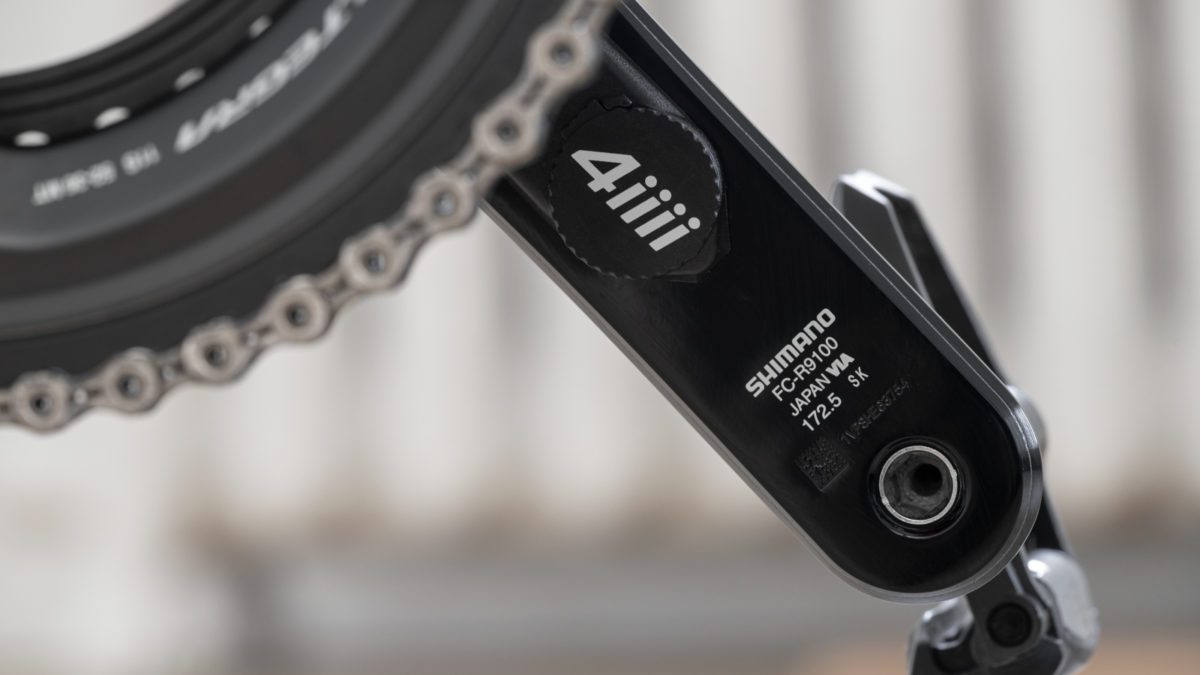First look: 4iiii Precision 3 left-side power meter
The latest device from the Cochrane, Alta., company for measuring your watts

Cochrane, Alta.’s 4iiii Innovations has a new power meter. It’s the 4iiii Precision 3. This left-side (that is, non-drive side) meter sits discreetly on the inside of your Shimano crank. The company says it’s 40 per cent thinner than previous models, giving it better clearance and compatibility with more bike frames than previous versions of the Precision.
The 4iiii Precision 3 specs
As with other 4iiii power meters, the Precision 3 is quite tiny, in a good way. It weighs only 9 g. Its accuracy is +/- 1 per cent. A CR2032 coin-cell battery can power the unit for a whopping 800 hours. My test power meter came installed on a Shimano Ultegra crank.
The 4iiii Precision 3 installation
Putting the power meter on your bike is pretty easy. Not quite as easy as putting on a pair a power pedals, but not much more challenging than that. The real trick is having the right tools on hand.
To remove the left-side Shimano crank, you first loosen its pinch bolts with an Allen key. Then, you take off the compression cap. For this step, you’ll need a specific tool to twist out the cap with an eight-point driver. Once the cap is off, lift the stop plate that sits in the middle of the pinch bolts. Slide the old crank off.
You can now slide the new crank with the 4iiii Precision 3 power meter on. While you’re here, you should put some grease on the spindle end and compression cap threads. After you slide the new crank on, make sure the stop plate engages correctly with the spindle. Put the compression cap back on. Tighten the pinch bolts evenly and to the recommended torque spec. Then give the cranks a spin. The power meter is ready to go.

Connecting the 4iiii Precision 3
The 4iiii Precision 3 transmits data via ANT+ and Bluetooth. I connected it quite easily to my Garmin Edge 530 and Wahoo Elemnt Roam via ANT+. To wake up the Precision 3, it’s best to spin up at least to 30 r.p.m., and then it reconnects quickly to the head unit.
The ANT+ connection to my Garmin was solid as the head unit captured my power on multiple test rides. The Wahoo worked fine, too. Things were a bit more challenging when it came to Bluetooth connections, which you might use when you’re connecting to a laptop, tablet or even smartphone for your Zwift rides. The Precision 3 broadcasts only one Bluetooth channel. If you are jumping between devices, you need to make sure you break the Precision 3’s connection with one device before heading to the other. Still, I’d find it quite difficult to get a consistent Bluetooth connection to either my laptop, tablet or phone for Zwift. I do use Xert’s training app on my iPhone fairly regularly. The Precision 3’s Bluetooth signal was just fine when I used this app.
ANT+ is really the protocol to use for the Precision 3. But even then, there’s the odd blip. To get the power meter connected to my laptop for a Zwift ride, I popped an ANT+ receiver in the computer’s USB port. That seemed to do the trick. Still, there were occasional drops as I rode through Watopia.
I often test power meters with an app called IpWatts, which I run on an old Sony smartphone with a built-in ANT+ receiver. It allows me to compare the numbers of a few meters simultaneously. The app, however, showed me something about the connectivity of the Precision 3. I noticed that the power readings were consistent as the smartphone sat on a shelf by my trainer setup. As I rode on the trainer, if I picked up the phone and held it close to my face (my eyesight is getting worse!), I noticed the readings from the Precision 3 would stop, freeze if you will, while the data from my Garmin Rally XC200 pedals kept flowing. It seems to me the Precision 3 has a short range. It’s fine beaming to your head unit mounted on your bars. But beyond that, not sure. So, when it comes to Zwift, keep your competitors close and your ANT+ receiver closer.

I’ve also been testing the Wahoo Kickr Rollr lately. For it to control your bike in Zwift, it needs to be paired with an on-bike power meter. The Precision 3 paired well with the Rollr. Then, I had no problems getting power readings from the Precision 3—ANT+ or Bluetooth—with the trainer as the intermediary. That, however, is a very specific work-around.
The 4iiii Precision 3’s power numbers
The power numbers I got from the Precision 3 tracked very closely with those from my Garmin Rally XC200 pedals. When I would throw in some sudden, hard accelerations, the Precision 3 was maybe a slight step behind the Rally, but I’d say this behaviour isn’t significant. The pedals give me dual-side power readings, while the Precision 3 is left-side only. If I favour my right leg in a jump, the Precision 3 won’t catch the acceleration right away.
Canadian pricing of the 4iiii Precision 3 power meter
| Model | Canadian Price |
|---|---|
| 4iiii Precision 3 factory install | $425 |
| 4iiii Precision 3, Shimano 105 R7000 | $425 |
| 4iiii Precision 3, Shimano Ultegra R8000 | $475 |
| 4iiii Precision 3, Shimano Dura-Ace R9100 | $605 |
| 4iiii Precision 3, Shimano GRX | $475 |
| 4iiii Precision 3, Shimano XT M8100 | $475 |
| 4iiii Precision 3, Shimano XTR M9100 | $635 |
First impressions of the 4iiii Precision 3 power meter
I really like the Precision 3’s small form factor and light weight. At 9 g, there are a whole host of other things to worry about when it comes to mass on the bike, like the long socks you might be wearing, for example. Installation is fairly easy, so that’s a plus. Also, by running a crank-based power meter, as opposed to a pedal-based one, you have a lot of freedom to run whatever pedals you want. The price for the Precision 3 is quite good. Compare it with single-sided Rally road pedals ($850) or single-sided Wahoo Powrlink Zero pedals ($840), and it comes out ahead. The Stages range of power meters are close to 4iiii in terms of form and price. At the moment, it looks like the 4iiii is close to $35 to $25 less expensive than Stages equivalents. With these factors in mind, the 4iiii Precision 3 makes a solid power meter for capturing your data out on pavement or gravel.

